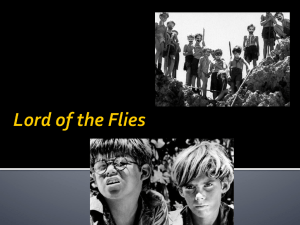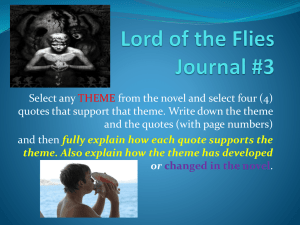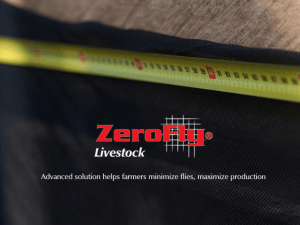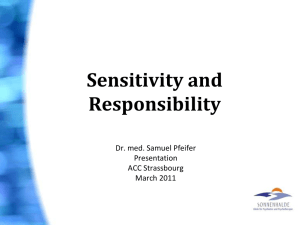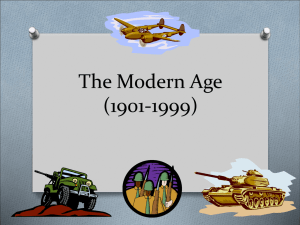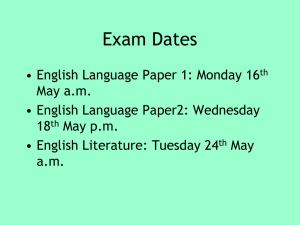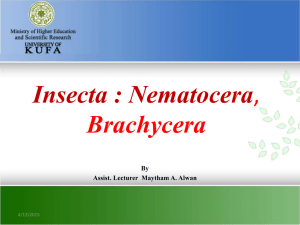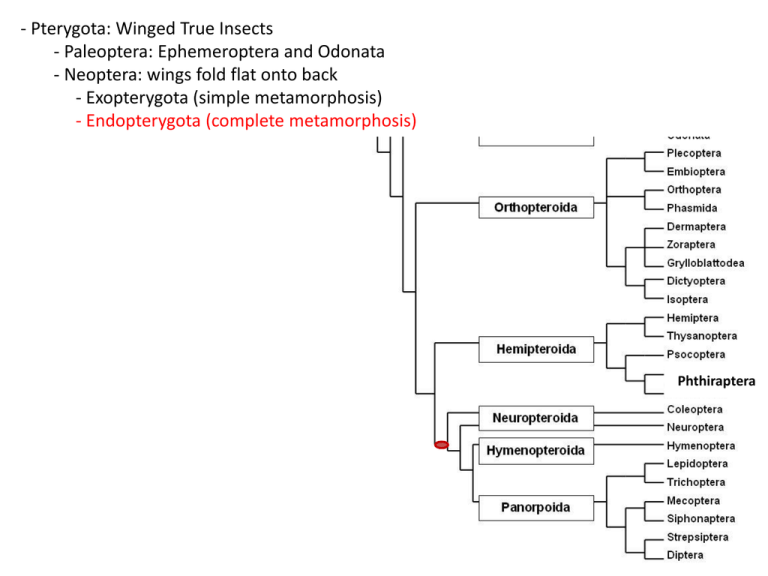
- Pterygota: Winged True Insects
- Paleoptera: Ephemeroptera and Odonata
- Neoptera: wings fold flat onto back
- Exopterygota (simple metamorphosis)
- Endopterygota (complete metamorphosis)
Phthiraptera
SUPERORDER: Panorpoidea
Order – Trichoptera: Caddisflies
- adults have hairy forewings, reduced chewing mouthparts, and long antennae
SUPERORDER: Panorpoidea
Order – Trichoptera: Caddisflies
- adults have hairy forewings, reduced chewing mouthparts, and long antennae
- larvae eruciform (caterpillar-like) with a well-developed head, legs, and a pair of anal claws
at end of abdomen. They often build cases. When the pupae is developed, it crawls out of the
case, goes to surface and emerges, and adult emerges.
SUPERORDER: Panorpoidea
Order – Trichoptera: Caddisflies
1. Hydroptilidae – Microcaddisflies (263)
- small, less than 6mm long
- mesoscutellum with posterior portion triangular with steep sides
- mesoscutum without warts
SUPERORDER: Panorpoidea
Order – Trichoptera: Caddisflies
1. Hydroptilidae – Microcaddisflies
2. Limnephilidae – Northern Caddisflies (239)
- anal area broad
- labrum long
SUPERORDER: Panorpoidea
Order – Trichoptera: Caddisflies
1. Hydroptilidae – Microcaddisflies
2. Limnephilidae – Northern Caddisflies
3. Hydropsychidae – Net-spinning Caddisflies (151)
- ocelli absent
- mesoscutum lacks warts
- Pterygota: Winged True Insects
- Paleoptera: Ephemeroptera and Odonata
- Neoptera: wings fold flat onto back
- Exopterygota (simple metamorphosis)
- Endopterygota (complete metamorphosis)
Phthiraptera
SUPERORDER: Panorpoidea
Order – Mecoptera: Scorpionflies
Mouthparts prolonged into a beak; four long membranous wings that are similar in venation
SUPERORDER: Panorpoidea
Order – Mecoptera: Scorpionflies
1. Panorpidae – Common Scorpionflies (54)
- males with enlarged, bulb-like genitals
- females abdomen tapers to two apical cerci
- adults and larva eat dead insects
SUPERORDER: Panorpoidea
Order – Mecoptera: Scorpionflies
1. Panorpidae – Common Scorpionflies
2. Bittacidae – Hangingflies (7)
- predaceous
- hang from vegetation and catch prey with raptorial hind legs
- males often give females a nuptial gift (prey) to entice mating
SUPERORDER: Panorpoidea
Order – Diptera: Flies
The distinguishing characteristic is 2 wings, with 2 halteres on metathorax.
Great guide to families:
SUPERORDER: Panorpoidea
Order – Diptera: Flies
The distinguishing characteristic is 2 wings, with 2 halteres on metathorax.
Mouthparts sucking, but modified to mopping, stabbing or reduced
Nematocera
SUPERORDER: Panorpoidea
Order – Diptera: Flies
- Suborder Nematocera: antennae with 6 or more freely articulating segments
SUPERORDER: Panorpoidea
Order – Diptera: Flies
- Suborder Nematocera: antennae with 6 or more freely articulating segments
1. Tipulidae – Crane Flies (1600)
- Adult: long thin legs and a “V-shaped” suture on the mesonotum; don’t feed
- ocelli absent
SUPERORDER: Panorpoidea
Order – Diptera: Flies
- Suborder Nematocera: antennae with 6 or more freely articulating segments
1. Tipulidae – Crane Flies (1600)
- Adult: long thin legs and a “V-shaped” suture on the mesonotum; don’t feed
- ocelli absent
- Larvae: mostly detrivivores, some predaceous, aquatic or soil
SUPERORDER: Panorpoidea
Order – Diptera: Flies
- Suborder Nematocera: antennae with 6 or more freely articulating segments
1. Tipulidae – Crane Flies
2. Ptychopteridae – Phantom Crane Flies (16)
- unmistakeble banded legs and gliding, floating flight
SUPERORDER: Panorpoidea
Order – Diptera: Flies
- Suborder Nematocera: antennae with 6 or more freely articulating segments
1. Tipulidae – Crane Flies
2. Ptychopteridae – Phantom Crane Flies
3. Anisopodidae – Wood Gnats
- ocelli present; look a bit crane fly like
- common species have brownish wings and triangular clear areas
SUPERORDER: Panorpoidea
Order – Diptera: Flies
- Suborder Nematocera: antennae with 6 or more freely articulating segments
1. Tipulidae – Crane Flies
2. Ptychopteridae – Phantom Crane Flies
3. Anisopodidae – Wood Gnats
4. Mycetophilidae – Fungus Gnats (700)
- mosquito-like, with reduced venation in wing; long coxae
SUPERORDER: Panorpoidea
Order – Diptera: Flies
- Suborder Nematocera: antennae with 6 or more freely articulating segments
1. Tipulidae – Crane Flies
2. Ptychopteridae – Phantom Crane Flies
3. Anisopodidae – Wood Gnats
4. Mycetophilidae – Fungus Gnats
5. Sciaridae – Dark-winged Fungus Gnats (170)
- much like mycetophilids, but with dark wings
- compound eyes almost meet above antennae
SUPERORDER: Panorpoidea
Order – Diptera: Flies
- Suborder Nematocera: antennae with 6 or more freely articulating segments
1. Tipulidae – Crane Flies
2. Ptychopteridae – Phantom Crane Flies
3. Anisopodidae – Wood Gnats
4. Mycetophilidae – Fungus Gnats
5. Sciaridae – Dark-winged Fungus Gnats
6. Psychodidae – Moth Flies and Sand Flies (112)
- small, wings with hairs on margin and long, parallel veins; body hairy
- often in moist, shady places and drains and sewers
- sand flies bite and can transmit viral diseases in tropics (leishmaniasis in S.A.)
Leischmania is a trypanosome protist. 30 species infect animals; 21 of these
can transmit to humans. Currently infect 12 million people
Cutaneous leishmaniasis at the bite site… also diffuse cutaneous (sores
eropt over body – looks like leprosy) visceral and mucocutaneous (nose
and mouth). New and Old World Tropics and China/Afghanistan
SUPERORDER: Panorpoidea
Order – Diptera: Flies
- Suborder Nematocera: antennae with 6 or more freely articulating segments
- Culicomorpha group
7. Ceratopagonidae – Biting Midges, No-seeums, “sand flies” (580)
- radial vein crowded along leading edge of wing; median vein 2-branched but hind branch
weak
- females suck blood of vertebrates and some other insects
SUPERORDER: Panorpoidea
Order – Diptera: Flies
- Suborder Nematocera: antennae with 6 or more freely articulating segments
- Culicomorpha group
7. Ceratopagonidae – Biting Midges, No-seeums
8. Chironomidae – Midges (1090)
- small (1-10mm) but very abundant
- don’t bite
- metanotum with keel or furrow
- plumose antenna
SUPERORDER: Panorpoidea
Order – Diptera: Flies
- Suborder Nematocera: antennae with 6 or more freely articulating segments
- Culicomorpha group
7. Ceratopagonidae – Biting Midges, No-seeums
8. Chironomidae – Midges (1090)
- small (1-10mm) but very abundant
- don’t bite
- metanotum with keel or furrow
- larvae are aquatic and sometimes abundant and red – “bloodworms”
- detritivores, also indicative of polluted water
SUPERORDER: Panorpoidea
Order – Diptera: Flies
- Suborder Nematocera: antennae with 6 or more freely articulating segments
- Culicomorpha group
7. Ceratopagonidae – Biting Midges, No-seeums
8. Chironomidae – Midges
9. Simuliidae – Black Flies (165)
- black, biting flies; often hump-backed…’buffalo flies’
- antennae short and stout…leading veins strong, posterior weak
SUPERORDER: Panorpoidea
Order – Diptera: Flies
- Suborder Nematocera: antennae with 6 or more freely articulating segments
- Culicomorpha group
7. Ceratopagonidae – Biting Midges, No-seeums
video
8. Chironomidae – Midges
9. Simuliidae – Black Flies (165)
video2
- black, biting flies; often hump-backed…’buffalo flies’
- antennae short and stout…leading veins strong, posterior weak
- larvae
SUPERORDER: Panorpoidea
Order – Diptera: Flies
- Suborder Nematocera: antennae with 6 or more freely articulating segments
- Culicomorpha group
7. Ceratopagonidae – Biting Midges, No-seeums
8. Chironomidae – Midges
9. Simuliidae – Black Flies
10. Culicidae – Mosquitoes (166)
- wings have scales along veins like moth flies
- long proboscis
SUPERORDER: Panorpoidea
Order – Diptera: Flies
- Suborder Nematocera: antennae with 6 or more freely articulating segments
- Culicomorpha group
7. Ceratopagonidae – Biting Midges, No-seeums
8. Chironomidae – Midges
9. Simuliidae – Black Flies
10. Culicidae – Mosquitoes (166)
- wings have scales along veins like moth flies
- long proboscis
- larvae aquatic
Life cycle
Encephalitis
West Nile virus
Dengue Fever
Malaria
Rift Valley Fever
Yellow Fever
Filariasis – nematode infections like elephantiasis
Killed more people than all the wars in history.
Malaria was the primary cause of death in tropical Africa until 1990’s and the
AIDS epidemic began
Anopheles carry malaria (Plasmodium protozoan) – 2 million deaths / year
Aedes carry dengue and yellow - viral
Nematocera
SUPERORDER: Panorpoidea
Order – Diptera: Flies
- Suborder Nematocera: antennae with 6 or more freely articulating segments
- Suborder Brachycera: antennae 5 or fewer segments (usually 3) often bearing a
terminal style or arista
SUPERORDER: Panorpoidea
Order – Diptera: Flies
- Suborder Nematocera: antennae with 6 or more freely articulating segments
- Suborder Brachycera: antennae 5 or fewer segments (usually 3) often bearing a
terminal style or arista
- empodium pulvilliform (tarsi with three pads)
PULVILLIFORM
BRISTLE-LIKE
SUPERORDER: Panorpoidea
Order – Diptera: Flies
- Suborder Nematocera: antennae with 6 or more freely articulating segments
- Suborder Brachycera: antennae 5 or fewer segments (usually 3) often bearing a
terminal style or arista
- empodium pulvilliform (tarsi with three pads)
11. Stratiomyidae – Soldier Flies (260)
- Radial vein branches are heavy and shifted anteriorly; costa doesn’t reach wingtip
- membrane behind closed cells has fine longitudinal wrinkles
SUPERORDER: Panorpoidea
Order – Diptera: Flies
- Suborder Nematocera: antennae with 6 or more freely articulating segments
- Suborder Brachycera: antennae 5 or fewer segments (usually 3) often bearing a
terminal style or arista
- empodium pulvilliform (tarsi with three pads)
11. Stratiomyidae – Soldier Flies
12. Tabanidae – Horse Flies and Deer Flies (317)
- upper and lower calypters large
SUPERORDER: Panorpoidea
Order – Diptera: Flies
- Suborder Nematocera: antennae with 6 or more freely articulating segments
- Suborder Brachycera: antennae 5 or fewer segments (usually 3) often bearing a
terminal style or arista
- empodium pulvilliform (tarsi with three pads)
11. Stratiomyidae – Soldier Flies
12. Tabanidae – Horse Flies and Deer Flies (317)
- upper and lower calypters large
- Postscutellum large
SUPERORDER: Panorpoidea
Order – Diptera: Flies
- Suborder Nematocera: antennae with 6 or more freely articulating segments
- Suborder Brachycera: antennae 5 or fewer segments (usually 3) often bearing a
terminal style or arista
- empodium pulvilliform (tarsi with three pads)
11. Stratiomyidae – Soldier Flies
12. Tabanidae – Horse Flies and Deer Flies (317)
- upper and lower calypters large
- Postscutellum large
- R4 +R5 divergent, enclosing wing tip
Deer Fly (Chrysops spp.)
Horse Fly (Tabanus spp.)
SUPERORDER: Panorpoidea
Order – Diptera: Flies
- Suborder Nematocera: antennae with 6 or more freely articulating segments
- Suborder Brachycera: antennae 5 or fewer segments (usually 3) often bearing a
terminal style or arista
- empodium pulvilliform (tarsi with three pads)
- empodium bristle-like
14. Phoridae – Hump-backed or Coffin Flies (370)
- Branches of R thickened and crowded into anterior of wing base; 3-4 weak veins with no
crossveins in rear half of wing
SUPERORDER: Panorpoidea
Order – Diptera: Flies
- Suborder Nematocera: antennae with 6 or more freely articulating segments
- Suborder Brachycera: antennae 5 or fewer segments (usually 3) often bearing a
terminal style or arista
- empodium pulvilliform (tarsi with three pads)
- empodium bristle-like
14. Phoridae – Hump-backed Flies (370)
- Branches of R thickened and crowded into anterior of wing base; 3-4 weak veins with no
crossveins in rear half of wing
- hump-backed; rapid, darting running; laterally flattened hind femora
video
SUPERORDER: Panorpoidea
Order – Diptera: Flies
- Suborder Nematocera: antennae with 6 or more freely articulating segments
- Suborder Brachycera: antennae 5 or fewer segments (usually 3) often bearing a
terminal style or arista
- empodium pulvilliform (tarsi with three pads)
- empodium bristle-like
14. Phoridae – Hump-backed Flies
15. Mydidae – Mydas Flies (55)
- a small group, but the most common eastern species is easy to identify by its
yellow/orange band across abdomen, clubbed 4-segmented antennae, and large, and dark
size and dark wings.
Mydas clavatus
SUPERORDER: Panorpoidea
Order – Diptera: Flies
- Suborder Nematocera: antennae with 6 or more freely articulating segments
- Suborder Brachycera: antennae 5 or fewer segments (usually 3) often bearing a
terminal style or arista
- empodium pulvilliform (tarsi with three pads)
- empodium bristle-like
14. Phoridae – Hump-backed Flies
15. Mydidae – Mydas Flies
16. Asilidae – Robber Flies (~1000)
- vertex sunken so top of head between eyes is concave; eyes never holoptic
- some stout; some very slender; prey on other insects, often in flight
SUPERORDER: Panorpoidea
Order – Diptera: Flies
- Suborder Nematocera: antennae with 6 or more freely articulating segments
- Suborder Brachycera: antennae 5 or fewer segments (usually 3) often bearing a
terminal style or arista
- empodium pulvilliform (tarsi with three pads)
- empodium bristle-like
14. Phoridae – Hump-backed Flies
15. Mydidae – Mydas Flies
16. Asilidae – Robber Flies
17. Bombyliidae – Bee Flies (900)
- short, fuzzy, with a long proboscis
- hover and buzz
- larvae parasitic on hymenoptera and other insects
SUPERORDER: Panorpoidea
Order – Diptera: Flies
- Suborder Nematocera: antennae with 6 or more freely articulating segments
- Suborder Brachycera: antennae 5 or fewer segments (usually 3) often bearing a
terminal style or arista
- empodium pulvilliform (tarsi with three pads)
- empodium bristle-like
14. Phoridae – Hump-backed Flies
15. Mydidae – Mydas Flies
16. Asilidae – Robber Flies
17. Bombyliidae – Bee Flies
18. Empididae – Dance Flies (760)
- small, dark flies
- neither hairy nor metallic
- large thorax and tapering abdomen; male genitalia
often prominent
SUPERORDER: Panorpoidea
Order – Diptera: Flies
- Suborder Nematocera: antennae with 6 or more freely articulating segments
- Suborder Brachycera: antennae 5 or fewer segments (usually 3) often bearing a
terminal style or arista
- empodium pulvilliform (tarsi with three pads)
- empodium bristle-like
19. Dolichopodidae – Long-legged Flies (1,275)
- metallic green or copper; predatory on smaller insects
- male genitialia folded under abdomen
SUPERORDER: Panorpoidea
Order – Diptera: Flies
- Suborder Nematocera: antennae with 6 or more freely articulating segments
- Suborder Brachycera: antennae 5 or fewer segments (usually 3) often bearing a
terminal style or arista
- empodium pulvilliform (tarsi with three pads)
- empodium bristle-like
19. Dolichopodidae – Long-legged Flies
20. Pipunculidae – Big-headed Flies (128)
- not abundant, but easily identified
SUPERORDER: Panorpoidea
Order – Diptera: Flies
- Suborder Nematocera: antennae with 6 or more freely articulating segments
- Suborder Brachycera: antennae 5 or fewer segments (usually 3) often bearing a
terminal style or arista
- empodium pulvilliform (tarsi with three pads)
- empodium bristle-like
19. Dolichopodidae – Long-legged Flies
20. Pipunculidae – Big-headed Flies
21. Platypezidae – Flat-footed Flies
- hind tarsi expanded and touch surface
SUPERORDER: Panorpoidea
Order – Diptera: Flies
- Suborder Nematocera: antennae with 6 or more freely articulating segments
- Suborder Brachycera: antennae 5 or fewer segments (usually 3) often bearing a
terminal style or arista
- empodium pulvilliform (tarsi with three pads)
- empodium bristle-like
19. Dolichopodidae – Long-legged Flies
20. Pipunculidae – Big-headed Flies
21. Platypezidae – Flat-footed Flies
22. Syrphidae – Hover Flies (870)
- experts of mimicry, but not dangerous
- hover around vegetation
- extra vein between R and M, called the ‘spurious vein’
SUPERORDER: Panorpoidea
- empodium bristle-like, calypter present (Calypterate muscoid flies)
23. Calliphoridae – Blow flies
- metallic blue or green
- most are scavengers, some are parasites (screw worm)
SUPERORDER: Panorpoidea
- empodium bristle-like, calypter present (Calypterate muscoid flies)
23. Calliphoridae – Blow flies
24. Muscidae – House/Latrine Flies (620)
- larvae live in filth and excrement; carriers of typhoid and other diseases
- Musca domestica (L.)
SUPERORDER: Panorpoidea
- empodium bristle-like, calypter present (Calypterate muscoid flies)
23. Calliphoridae – Blow flies
24. Muscidae – House/Latrine Flies
25. Tachinidae – Tachinid Flies (1,350)
- lots of bristles on abdomen
- R5 cell narrowed distally, postscutellum developed
- parasites of many insects, particularly lep’s
video
SUPERORDER: Panorpoidea
- empodium bristle-like, calypter absent (Acalypterate muscoid flies)
26. Micropezidae – Stilt-legged Flies (33)
- not a big group, but easily identified by the elongate body and waving of front legs.
SUPERORDER: Panorpoidea
- empodium bristle-like, calypter absent (Acalypterate muscoid flies)
26. Micropezidae – Stilt-legged Flies
27. Conopidae – Thick-headed Flies
- often wasps or bee mimics; they grab them in flight and lay an egg on them, which
burrows in and is endoparasitic.
- large proboscis
SUPERORDER: Panorpoidea
- empodium bristle-like, calypter absent (Acalypterate muscoid flies)
26. Micropezidae – Stilt-legged Flies
27. Conopidae – Thick-headed Flies
28. Tephritidae – True Fruit Flies
- often with patterns on the wing – may be spider mimic
- pests of apples (Apple maggot fly), citrus (Med. Fruit fly)
Goldenrod gall fly (Eurosta)
video
SUPERORDER: Panorpoidea
- empodium bristle-like, calypter absent (Acalypterate muscoid flies)
26. Micropezidae – Stilt-legged Flies
27. Conopidae – Thick-headed Flies
28. Tephritidae – True Fruit Flies
29. Chloropidae – Grass Flies (290)
- larvae feed on grass stems, some are serious pests of cereals
- some adults drawn to animal secretions, even at the eye – ‘eye gnats’
SUPERORDER: Panorpoidea
- empodium bristle-like, calypter absent (Acalypterate muscoid flies)
26. Micropezidae – Stilt-legged Flies
27. Conopidae – Thick-headed Flies
28. Tephritidae – True Fruit Flies
29. Chloropidae – Grass Flies
30. Sphaeroceridae – Small Dung Flies (250)
- basal tarsi bulbous on hind leg
- common around dung and in marshes
SUPERORDER: Panorpoidea
- empodium bristle-like, calypter absent (Acalypterate muscoid flies)
26. Micropezidae – Stilt-legged Flies
27. Conopidae – Thick-headed Flies
28. Tephritidae – True Fruit Flies
29. Chloropidae – Grass Flies
30. Sphaeroceridae – Small Dung Flies (250)
31. Drosophilidae – Pomace Flies (182)
SUPERORDER: Panorpoidea
- empodium bristle-like, calypter absent (Acalypterate muscoid flies)
26. Micropezidae – Stilt-legged Flies
27. Conopidae – Thick-headed Flies
28. Tephritidae – True Fruit Flies
29. Chloropidae – Grass Flies
30. Sphaeroceridae – Small Dung Flies
31. Drosophilidae – Pomace Flies
32. Ephydridae – Shore Flies(463)
- often in great numbers along shores
- some with large, raptorial forelegs

